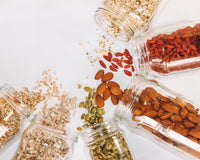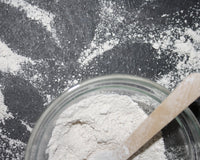easier with a well stocked pantry. Whether you’re making elaborate meals or just
quick snacks, having an array of whole foods at your disposal is overwhelmingly
beneficial. Not only does cooking at home save money, but by opting for whole foods
you can avoid all of those nasty additives that are far too dominant in ready meals.
In this article we’ll go over some of the best whole foods to keep at hand in your
kitchen, how to use them and most importantly their health benefits.
1. Rice, which one to pick and how to cook it perfectly.
There are countless varieties of rice out there, so for now we’ll just cover some of our
top picks, and some useful tips. The first thing to decide when cooking with rice is
whether you want to use long, medium or short grain. Short grain rice (as the name
suggests) is smaller than its counterparts, with a starchier texture, like sushi rice for
example. Long grain rice, like basmati, on the other hand is longer, thinner and
fluffier, making it a good all rounder. Finally medium grain rice fits in between the
two, it has the size and shape of long grain rice, but with the texture of short grain
rice, making it ideal for savoury creamy recipes like risotto.
However, if you’re looking for the healthiest whole food option above all else, your
best bet is to go for either long grain brown rice or wild rice. Both brown and wild
rice are packed full of fibre, protein and a variety of vitamins and minerals, while also
having low to middling glycaemic indexes, making both of them a great source of
slow burning energy.
Two top tips to cook rice perfectly every time.
- It is always best to thoroughly wash your rice before you cook it, not just to remove
any unwanted debris but also to remove excess starch. Excess starch is often what
gives rice an unpleasant sludge-like texture which can derail an entire meal.
- Different ratios of water to rice can drastically alter the texture of your rice, for
example when cooking white rice, a ratio of 2:1 (liquid to rice) will produce a softer
rice, whereas a ratio of 1:1 will produce a tougher chewier final result.
Quinoa is an incredible superfood that definitely deserves a place in your pantry,
mainly because of its status as a complete protein. The term complete protein refers
to a food that contains all 9 amino acids that humans can’t produce on their own.
Outside of animal products, complete proteins can be quite hard to come by, making
quinoa especially useful for those on plant based or vegan diets. As well as being
protein-dense, quinoa is a great source of iron, magnesium, potassium, vitamin E and
fibre.
How to cook with quinoa.
Quinoa is best used as an alternative to rice or couscous, and it is incredibly easy to
prepare. Simply add quinoa to a pan with water, bring it to a boil and then simmer for
around 15 minutes before draining, then fluff with a fork and enjoy.
If you’re stumped and looking for a good place to start, we recommend this easy
quinoa and bean salad, packed full of nutrients and great on a hot summer’s day.
3. Nuts, perfect for snacking, baking and cooking.
Each nut is different, with their own uses, flavours and all important health benefits,
and while we can’t cover all of them here, here are some of our favourites.
- Almonds are packed full of healthy fats, protein, fibre and vitamins, making
them one of the best nuts to incorporate into your diet. Whether you’re baking
with them, using them to make flour or butter, or just snacking on them
straight from the bag, they are truly incredible.
- Walnuts are an amazing source of omega 3 fatty acids, in particular alpha
linoleic acid, which is incredibly important in reducing inflammation and
could even lower the risk of heart disease. Walnuts are incredibly versatile and
work perfectly in salads, breakfasts, sauces, and of course in baking.
- Brazil nuts are one of the best sources of antioxidants you can come by, but
they also contain the vital nutrient, selenium. Selenium is crucial for countless
bodily functions, including thyroid function and support of the immune
system. Brazil nuts can make for a great snack, but they really shine when
used in baking, or as a means to really boost the nutritional content of a meal.
4. Seeds, a quick and easy way to make a meal even healthier.
Much like nuts, there are obviously too many types of seeds to cover here, so we’ll go
through a couple of our best picks.
powerful tool for maintaining a healthy heart and a good immune system. Raw
or roasted, pumpkin seeds can be a delicious snack on their own, or work
amazingly as a healthy salad topper.
- Sunflower seeds, like walnuts, contain an abundance of fatty acids, in
particular the fatty acid linoleic acid. On top of their healthy fat content,
sunflower seeds are also rich in protein, magnesium and zinc, making them a
great all-rounder. Just like pumpkin seeds, sunflower seeds work as a snack, in
baking or as an ingredient in healthy savoury meals.
Why you should stock your pantry with whole foods.
These whole food staples we’ve mentioned above are just the start, there are so many
more that deserve a place in your kitchen. Whether you’re looking for herbs, spices,
proteins or fruits, by stocking up on whole foods, you can really give your cooking a
significant healthy boost. Not only do whole foods contain far more nutrients than
processed foods, they are also the best way to avoid harmful ingredients, while also
keeping your bank account healthy at the same time. So don’t hesitate to jump into
the world of Whole Foods, you’ll notice the difference in no time.






